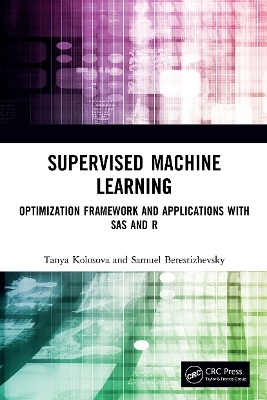
Supervised Machine Learning
Chapman & Hall/CRC (Verlag)
978-0-367-53882-8 (ISBN)
AI framework intended to solve a problem of bias-variance tradeoff for supervised learning methods in real-life applications. The AI framework comprises of bootstrapping to create multiple training and testing data sets with various characteristics, design and analysis of statistical experiments to identify optimal feature subsets and optimal hyper-parameters for ML methods, data contamination to test for the robustness of the classifiers.
Key Features:
Using ML methods by itself doesn’t ensure building classifiers that generalize well for new data
Identifying optimal feature subsets and hyper-parameters of ML methods can be resolved using design and analysis of statistical experiments
Using a bootstrapping approach to massive sampling of training and tests datasets with various data characteristics (e.g.: contaminated training sets) allows dealing with bias
Developing of SAS-based table-driven environment allows managing all meta-data related to the proposed AI framework and creating interoperability with R libraries to accomplish variety of statistical and machine-learning tasks
Computer programs in R and SAS that create AI framework are available on GitHub
Tanya Kolosova is a statistician, software engineer, an educator, and a co-author of two books on statistical analysis and metadata-based applications development using SAS. Tanya is an actionable analytics expert, she has extensive knowledge of software development methods and technologies, artificial intelligence methods and algorithms, and statistically designed experiments. Samuel Berestizhevsky is a statistician, researcher and software engineer. Together with Tanya, Samuel co-authored two books on statistical analysis and metadata-based applications development using SAS. Samuel is an innovator and an expert in the area of automated actionable analytics and artificial intelligence solutions. His extensive knowledge of software development methods, technologies and algorithms allows him to develop solutions on the cutting edge of science.
Introduction. PART 1 1.Introduction to the AI framework. 2.Supervised Machine Learning and Its Deployment in SAS and R. 3.Bootstrap methods and Its Deployment in SAS and R. 4.Outliers Detection and Its Deployment in SAS and R. 5.Design of Experiment and Its Deployment in SAS and R. PART II 1.Introduction to the SAS and R based table-driven environment. 2.Input Data component. 3.Design of Experiment for Machine-Learning component. 4.“Contaminated” Training Datasets Component. PART III 1.Insurance Industry: Underwriters decision-making process. 2.Insurance Industry: Claims Modeling and Prediction. Index.
| Erscheinungsdatum | 21.04.2022 |
|---|---|
| Zusatzinfo | 59 Tables, black and white; 22 Line drawings, black and white; 22 Illustrations, black and white |
| Sprache | englisch |
| Maße | 156 x 234 mm |
| Gewicht | 340 g |
| Themenwelt | Informatik ► Theorie / Studium ► Künstliche Intelligenz / Robotik |
| Mathematik / Informatik ► Mathematik | |
| Technik ► Elektrotechnik / Energietechnik | |
| Technik ► Umwelttechnik / Biotechnologie | |
| ISBN-10 | 0-367-53882-2 / 0367538822 |
| ISBN-13 | 978-0-367-53882-8 / 9780367538828 |
| Zustand | Neuware |
| Informationen gemäß Produktsicherheitsverordnung (GPSR) | |
| Haben Sie eine Frage zum Produkt? |
aus dem Bereich


